#Low-code Development
Explore tagged Tumblr posts
Text
Product Engineering in Software Engineering: Latest Trends
Explore how Product Engineering in Software Engineering drives innovation with AI, cloud, low-code, and modern development trends.
Building digital products today requires more than just good code. As a result, companies are shifting to smarter product development methods. As businesses strive to meet rising customer expectations, they often seek help from a software product engineering services company.
These companies combine technology, design, and strategy to bring innovation faster and more reliably.
Therefore, let’s explore how product engineering in software engineering is evolving and what trends are shaping its future.
Why Product Engineering in Software Engineering Drives Modern Products
The idea behind product engineering in software engineering is to build digital products that solve real problems quickly and efficiently. Rather than creating products in silos, teams now work together using shared goals, fast feedback, and constant iteration.
Continuous Discovery
First of all, product teams no longer wait months to understand customer needs. Instead, they perform weekly research sprints to validate every new idea. These discoveries reduce rework and help create user-focused solutions from day one. Furthermore, continuous discovery aligns the product vision with real-time market shifts.
Secure by Design
In the past, security was a final step in the product life cycle. Now, developers integrate security scans into their daily coding process. This proactive approach prevents threats and saves time on future fixes. Additionally, building security from the start improves trust and reduces compliance risks………….
#Product Engineering in Software Engineering#Software Product Engineering Services#AI in Product Development#Low-Code Development#Cloud Product Engineering#Edge Computing Trends#Composable Architecture#Responsible AI#Hyper-Personalization#Sustainable DevOps#Digital Product Innovation#Future Skills for Product Teams#Cloud-Native Security#Continuous Discovery#Irom Technologies
0 notes
Text
Low-Code Development
Low-code development allows businesses to build applications quickly with minimal hand-coding, using visual interfaces and pre-built modules. It speeds up development, reduces costs, and empowers both developers and non-technical users to create solutions faster. This approach is ideal for rapid prototyping and scaling digital products. At Mindpath, we offer professional low-code development services to turn your ideas into reality. For more, visit: https://www.mindpathtech.com/blog/low-code-development/

0 notes
Text
Revolutionizing Software Solutions with Low-Code and No-Code Development
In today’s fast-paced digital era, businesses need agile and scalable software solutions that can evolve with their needs. This is where Low-Code Development and No-Code Development come into play. At CodeReady Software, we specialize in empowering businesses of all sizes with efficient, innovative, and cost-effective digital solutions through cutting-edge development techniques.
What is Low-Code and No-Code Development?
Low-Code Development and No-Code Development are modern approaches that simplify the software development process. Instead of writing thousands of lines of code, developers and even non-developers can use drag-and-drop interfaces and pre-built templates to build powerful applications quickly.
While low code platforms require minimal coding knowledge, no code platforms are designed for users with no technical background at all. This opens the door to faster innovation, reduced development costs, and greater accessibility for all types of users.

The Rise of Low Code No Code App Development
As technology continues to evolve, low code no code app development is becoming a game-changer for businesses. Whether you need an internal tool, a customer-facing app, or a fully functional enterprise-grade system, these platforms enable rapid development and deployment without compromising on quality.
At CodeReady Software, we specialize in delivering high-performance applications tailored to your business goals, using the latest in low-code and no-code technologies.
Custom Software Development with Speed and Flexibility
While off-the-shelf software can solve some business challenges, every organization has unique needs. This is why Custom Software Development remains crucial. By combining custom development strategies with low code app development, we build solutions that are not only tailored to your requirements but also scalable and future-ready.
Our experienced team at CodeReady Software follows a streamlined development process that includes:
Business analysis
UI/UX design
Visual development
API integration
Testing and deployment
Whether you're a startup or an established enterprise, our solutions are designed to grow with your business.
Why Choose CodeReady Software?
We don’t just build apps—we build experiences. Our commitment to low-code and no-code development ensures that we deliver software faster, more efficiently, and with unmatched quality.
Here’s what sets us apart:
Faster time-to-market
Cost-effective development
Scalable and flexible solutions
Seamless integration with existing systems
Post-deployment support and maintenance
From idea to execution, CodeReady Software is your trusted partner for custom software development and low code app development.
Conclusion
The future of digital transformation lies in simplification. By leveraging Low-Code Development, No-Code Development, and custom strategies, CodeReady Software is helping businesses accelerate innovation and achieve their goals faster than ever before.
Ready to build your next app the smart way? Let’s connect and turn your vision into reality with the power of low code no code app development.
#Low-Code Development#No-Code Development#low code no code App Development#Custom Software Development#low code app development
0 notes
Text
6 Things That You Need in Your Sales CRM
6 Things That You Need in Your Sales CRM
Choosing the right Sales CRM is crucial for boosting your sales process, improving customer relationships, and optimizing team productivity. However, with the rise of digital transformation, the integration of low-code and no-code platforms in CRM solutions has revolutionized how businesses tailor their tools. Below are six essential features that every best sales CRM should offer.
1. Seamless Integration with Other Tools
A top-tier CRM needs to integrate smoothly with other business tools, such as email marketing platforms, calendars, and social media management tools. This allows your team to streamline operations and centralize customer data in one place. For businesses looking to integrate additional features quickly, low-code application development can provide flexibility in connecting different tools without requiring extensive coding knowledge. Learn more about how low-code software can simplify integrations in your CRM
2. Customizable Dashboard
Every business is unique, and your CRM dashboard should reflect that. With a customizable dashboard, your team can view the metrics that matter most to them, from lead tracking to sales reports. Low-code development allows you to personalize the CRM interface with minimal effort, ensuring that each user has an optimized experience. If you're looking for a CRM that allows customization at scale, consider leveraging low-code platforms for mobile app development to create mobile-optimized dashboards.
3. Automation for Lead Management
Automation is a game-changer when it comes to lead management. By automating repetitive tasks, such as sending follow-up emails or reminders, your sales reps can focus on building meaningful relationships with clients. With low-code application development, automating processes becomes much more accessible, reducing the reliance on technical teams and speeding up deployment. Want to learn how automation can improve your CRM's performance? Check out Amoga’s CRM.
4. Real-Time Data and Analytics
In the fast-paced world of sales, having access to real-time data is essential. A CRM solution should provide dynamic dashboards and analytics that give you an up-to-date view of your customer interactions, sales pipeline, and team performance. With the advent of low-code platforms, integrating advanced analytics features into your CRM has never been easier, enabling real-time updates and empowering your team to make data-driven decisions.
5. Mobile Accessibility
In today’s mobile-driven world, your sales team needs a CRM that works on-the-go. A mobile-optimized CRM ensures that your reps have access to key customer data anytime, anywhere. The rise of low-code platforms for mobile app development has made it easier for businesses to create tailored mobile apps that integrate seamlessly with their CRM, helping your team stay connected and efficient while out of the office.
6. Comprehensive Customer Support
A CRM that provides comprehensive customer support can make all the difference. Whether it's onboarding, troubleshooting, or advanced configurations, great support ensures that your team can maximize the CRM’s potential. Many low-code software solutions offer built-in support systems or simple configurations that minimize the need for extensive technical assistance, helping your team get the most out of their CRM quickly.
#low code no code platforms for mobile app development#low-code development#low code application developmet#low-code software
0 notes
Text
The Future of Cloud App Development: Unlocking Business Value
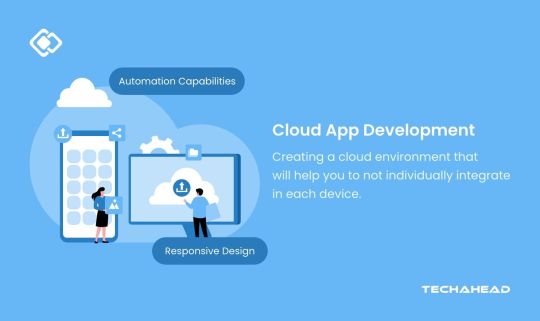
Cloud computing is rapidly transforming businesses. Many industry reports reveal that as business mobile applications grow, over 70% of digital workspaces face challenges with storage capacity and performance. The ideal solution to these issues is cloud app development, which provides unmatched scalability and flexibility.
Cloud app development simplifies data collection, enabling businesses to gather insights faster and more efficiently. It also enhances data security and streamlines management, making compliance and administration less burdensome. Cloud-powered development solutions empower businesses to create high-performance, productivity-focused applications that drive customer satisfaction and boost revenue.
Furthermore, cloud software solutions support low-code development, a time- and cost-efficient approach that minimizes extensive coding. This allows businesses to launch applications faster, optimizing resource usage and accelerating innovation cycles.
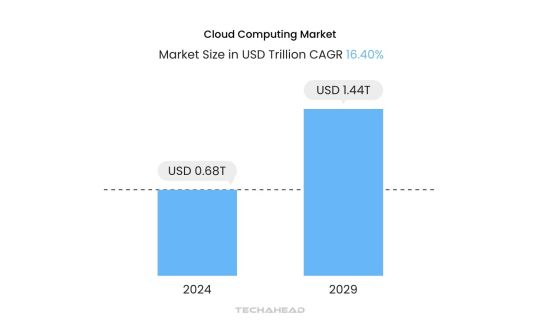
The cloud computing market is projected to grow substantially, with an estimated size of USD 0.68 trillion in 2024, anticipated to reach USD 1.44 trillion by 2029 at a CAGR of 16.40% (source: Mordor Intelligence). This robust growth highlights the rising demand for cloud solutions across industries. However, this rapid expansion in cloud applications prompts critical questions for businesses, especially around best practices in cloud app development.
In this guide, we’ll explore how to approach cloud app development effectively, the diverse cloud-based application solutions available, and how they drive value. You’ll gain insights into creating cloud applications that enhance operational efficiency, scalability, and customer engagement.
Let’s begin by examining the essentials that pave the way for efficient and future-ready cloud app development.
What is Cloud App Development?
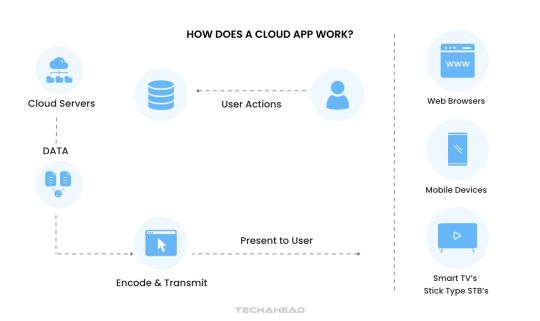
Cloud app development refers to creating applications within a cloud environment, bypassing the need for local servers. Unlike native applications, cloud-based apps rely extensively on cloud app development services, including data storage and processing, making them accessible through web browsers and other online platforms.
As enterprise development grows more reliant on cloud capabilities, they have leveraged its computational power to build groundbreaking solutions, transforming what’s possible in technology. Cloud services now empower companies to create a vast range of cloud applications that operate seamlessly on the web, often known as web apps.
These cloud apps are reshaping various business functions, taking over essential tasks like email, word processing, file storage, data collection, and even financial accounting. Through cloud app development, organizations are equipped with efficiency, streamline operations, and scale solutions like never before.
Types of Cloud App Development
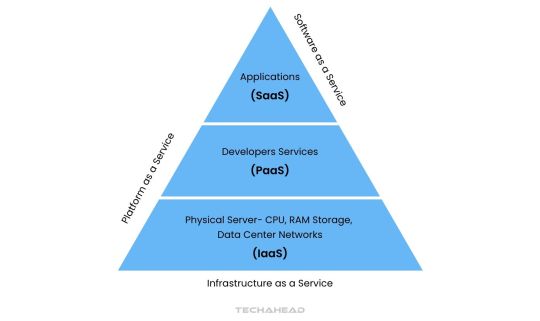
Software-as-a-Service (SaaS)
SaaS applications are hosted and maintained entirely by a cloud provider, making them accessible via the internet through web browsers. These applications relieve businesses from handling updates, server management, and software installations, as all maintenance is centrally managed by the provider. Users can seamlessly access features, integrate productivity tools, and share data across teams, which enhances operational efficiency.
Solutions like Google Workspace, Salesforce, and Slack exemplify SaaS by providing essential tools for collaboration, sales, and project management within a single, easily accessible platform.
Platform-as-a-Service (PaaS)
PaaS offers a managed environment for application development, which includes tools for building, testing, and deploying software while the cloud provider oversees infrastructure. By managing hardware and backend services, PaaS enables development teams to focus solely on cloud app development without the burden of configuring servers or databases. This platform accelerates time-to-market and streamlines scaling since the underlying resources are automatically adjusted as demand increases.
Examples like Microsoft Azure App Services and Google App Engine give developers robust frameworks and APIs, helping them build complex applications with minimal operational overhead.
Infrastructure-as-a-Service (IaaS)
IaaS delivers essential computing infrastructure such as virtual servers, storage, and networking resources. Unlike traditional on-premises infrastructure, IaaS allows businesses to pay for only the resources they use, which is ideal for scaling and managing large workloads flexibly. This model offers extensive control over the infrastructure, enabling IT teams to customize their environments and manage systems as needed.
Leading providers like AWS, Azure, and Google Cloud Platform provide services that allow companies to extend, scale, and secure their infrastructure easily, aligning with cloud app development needs for flexibility and resilience.
Function-as-a-Service (FaaS)
FaaS is part of serverless computing, allowing developers to deploy discrete code functions triggered by specific events, like user actions or system updates. With FaaS, there’s no need to manage or scale servers manually; the cloud provider handles it automatically based on demand. This model is ideal for applications requiring quick responses to high volumes of concurrent events, as it enhances cost efficiency and operational simplicity.
Popular FaaS services include AWS Lambda and Google Cloud Functions, which cater to cloud app development that prioritizes lightweight, highly scalable, and event-driven functionality.
Container-as-a-Service (CaaS)
CaaS leverages containers—lightweight, portable units of software that package application code along with its dependencies—for more efficient deployment and scaling across different environments. This model is highly beneficial for businesses adopting microservices architectures, as containers improve consistency in app deployment from development to production. CaaS platforms utilize orchestration tools, like Kubernetes, to automate the deployment, scaling, and management of containerized applications across multiple cloud or on-premises environments.
CaaS aligns with cloud app development demands for agility, allowing applications to scale seamlessly across hybrid or multi-cloud setups without compatibility issues.
Features of Every Cloud App Development Should Have
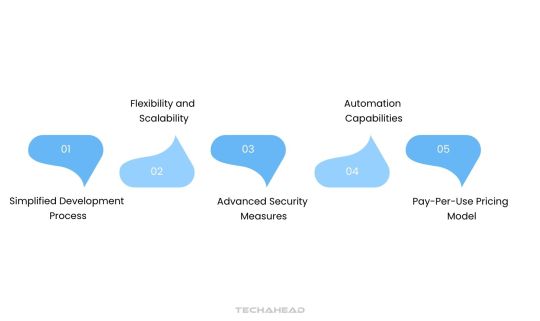
Simplified Development Process
An effective cloud app development platform should prioritize speed and simplicity. It should streamline architectural decisions, reducing complexity in creating and deploying applications across diverse technical environments. This simplicity allows hired developers to address challenges faster, minimizing errors and accelerating deployment. An efficient platform optimizes the overall development workflow, making it seamless to launch applications that meet high standards across various infrastructures.
Flexibility and Scalability
In cloud app development, flexibility is paramount. A robust platform should allow users to easily scale resources—adding or removing computing power, storage, and networking assets as demands fluctuate. Through automated scaling, these platforms adapt to dynamic workloads, preventing bottlenecks while ensuring optimal performance. During peak demand, a well-configured platform should instantly increase resources, and when demand lessens, it should scale down, maximizing cost-efficiency and resource allocation.
Advanced Security Measures
Security in cloud app development is a core feature, as cloud platforms employ top-tier security experts dedicated to threat management. These platforms adhere to stringent security protocols, often exceeding the protection provided by in-house teams. With compliance measures integrated, organizations can meet industry and governmental regulations effortlessly. Notably, 91% of companies report improved regulatory compliance post-cloud migration, emphasizing the cloud’s ability to safeguard data and ensure confidentiality.
You can also learn about the pillars of AI security and how it is protecting future technology.
Automation Capabilities
Automated processes are vital for managing complex, repetitive tasks in cloud app development. Advanced platforms support continuous integration and resource orchestration, which reduce operational burdens. Automation tools manage workload scaling, ensuring resources are available when needed without manual intervention. This allows IT teams to support growing demands efficiently while concentrating on strategic initiatives, enhancing overall operational efficiency.
Pay-Per-Use Pricing Model
A pay-per-use model enhances cost control within cloud app development, as users only pay for what they consume. This approach eliminates unnecessary expenses, allowing businesses to scale resources economically. Cloud providers track and report usage metrics, helping users monitor and optimize expenses. Some providers also offer a base level of free storage or computing power, making cloud resources even more accessible for startups and small businesses.
Steps to Take While Developing a Cloud App
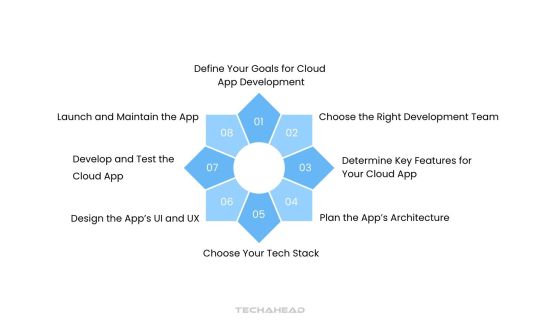
Creating a cloud app can involve web or mobile solutions, with the required technologies varying by solution type. Despite technical differences, the fundamental process in cloud app development follows similar phases to build a robust, user-centered application.
Step 1: Define Your Goals for Cloud App Development
Establishing clear objectives is crucial before development begins. Align all stakeholders on the project’s vision and goals during the discovery phase, helping the team understand the core business needs.
Reasons to consider cloud app development include:
Workflow automation: Streamlining repetitive tasks saves time and resources
Centralized data storage: Access and manage data easily within a single, organized environment.
Enhanced team collaboration: Improve internal communication and ensure seamless data exchanges.
Advanced reporting and analytics: Gain valuable insights to drive data-based decisions.
The discovery phase also allows developers to identify project scope, complexities, potential challenges, and costs. If a swift market entry is critical, a Minimum Viable Product (MVP) may be the best first step.
Step 2: Choose the Right Development Team
Cloud app development requires specialized skills, so selecting the right development team is essential. You can opt for freelancers, in-house talent, or outsource to a software development company.
Choosing a reliable cloud app development partner ensures ongoing support as the app evolves. Here are some questions to assess potential developers:
Can you share similar cloud app projects you have handled?
What platforms and technologies are you skilled in?
How do you prioritize security and scalability in development?
How do you approach cost management for cloud resources?
Can you ensure effective collaboration throughout the project?
A reliable development partner can adapt the app as technology advances and business needs grow.
Step 3: Determine Key Features for Your Cloud App
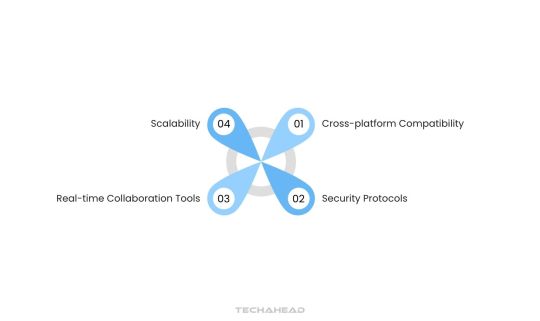
Identify core features that create a user-friendly experience in cloud applications. Essential features include:
Cross-platform compatibility: Allow users to access the app on their preferred devices.
Security protocols: Implement logins and access controls to protect user data.
Real-time collaboration tools: Enable users to work together through features like chat, live comments, and shared documents.
Scalability: Ensure the app can handle increasing users or workload.
Incorporating these features enhances user satisfaction and engagement, setting your app up for success.
Step 4: Plan the App’s Architecture
Your app’s architecture is the backbone of cloud app development, influencing scalability, security, and cost efficiency. Choose an architecture that aligns with your project’s requirements.
Key options include:
Monolithic architecture: A single, interconnected application; easy to develop but challenging to scale.
Microservices architecture: Divides the app into independent services; highly scalable but may face performance trade-offs.
Serverless architecture: Uses event-triggered functions in a serverless environment, ideal for low-maintenance, scalable solutions.
Hybrid architecture: Combines on-premises and cloud resources for high flexibility but may involve integration complexities.
Select an architecture that best aligns with your cloud app development goals. You can also look into this guide on Serverless Vs. Microservices architecture.
Step 5: Choose Your Tech Stack
The technology stack determines how quickly, securely, and effectively the app functions. Different projects require different combinations of programming languages (e.g., Java, Python, Node.js), databases (e.g., MongoDB, Firebase), frameworks (e.g., React, Angular), and containers (e.g., Docker, Kubernetes).
For instance, a Python-based stack offers scalability and maintenance ease, while Ruby on Rails works well for prototyping and collaboration. Choose the right tech stack that aligns with your app’s performance and integration needs.
Step 6: Design the App’s User Interface (UI) and User Experience (UX)
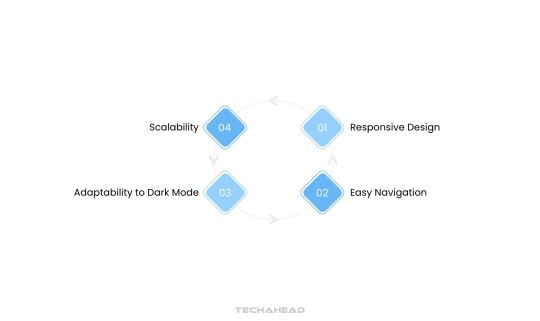
Effective UI/UX design is vital in cloud app development to create intuitive and visually appealing apps. Consider these elements:
Responsive design: Ensure seamless functionality across platforms and screen sizes.
Easy navigation: Users should quickly find what they need with minimal guidance.
Adaptability to dark mode: Offer both light and dark modes to reduce eye strain.
Scalability: Design a UI that accommodates future growth and additional features.
A responsive, intuitive, and adaptable UI makes the app user-friendly and future-proof. You can learn more about the Mobile UI designs as well.
Step 7: Develop and Test the Cloud App
Cloud app development typically uses Agile or DevOps methodologies, depending on project needs and team preferences.
Agile development emphasizes short, iterative development cycles, with regular testing and feedback after each sprint. Agile promotes flexibility, allowing the team to adapt to evolving requirements.
DevOps fosters collaboration across development and operations, with a focus on Continuous Integration/Continuous Delivery (CI/CD) and automation for efficient testing and deployment.
Both approaches streamline development, but the choice depends on team readiness and project goals.
Step 8: Launch and Maintain the App
Successful cloud app development doesn’t end with deployment. Continuous maintenance keeps your app relevant, responsive, and secure. Essential areas include:
Security updates: Regular patches to safeguard user data.
Performance optimization: Keep the app fast and responsive as usage grows.
Scalability adjustments: Ensure the app scales efficiently as demand fluctuates.
Technology updates: Adapt the stack to new versions or libraries.
Ongoing maintenance ensures a secure, scalable, and high-performing cloud app that keeps pace with technological advancements and user expectations.
Benefits of Cloud App Development
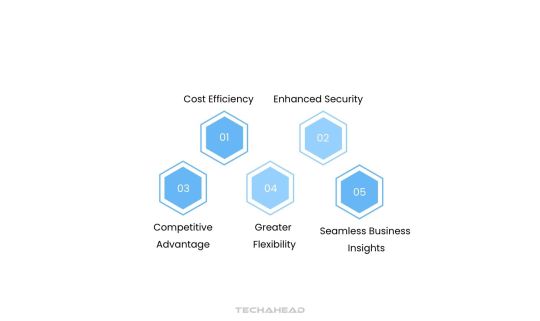
Cost Efficiency
Cloud app development significantly reduces costs by eliminating the need for on-premise infrastructure. With cloud-based applications, businesses only pay for the services they use, making it approximately 40% more affordable for small companies. This pay-as-you-go model means businesses can adjust monthly expenses based on usage, resulting in ongoing cost control.
Unlike traditional hardware, which requires significant upfront investment, cloud solutions offer flexible pricing that can scale with business growth. Additionally, many providers offer cost-saving options, like discounts on long-term contracts for larger enterprises.
You can learn more about the cost of app development.
Enhanced Security
Data security remains a huge priority when it comes to cloud app development. While integrating them, they tend to provide robust protection that safeguards sensitive information. Top cloud-based service providers employ advanced encryption techniques. It all helps in making it harder to get data accessibility for unauthorized users.
Even if there’s an intrusion attempt, encryption ensures data remains protected. Cloud hosting also includes 24/7 monitoring by specialized security teams, often surpassing the reliability of in-house systems. Research shows that 94% of businesses have reported enhanced data security after moving to cloud-based applications, demonstrating its effectiveness in managing data integrity and safety.
Competitive Advantage
Leveraging cloud app development gives companies a significant competitive edge. Cloud services handle infrastructure management, freeing up IT teams to focus on innovation and growth-centric initiatives. With a faster deployment cycle and access to the latest cloud technologies, cloud-enabled companies stay ahead in a rapidly evolving market.
Studies indicate that 77% of organizations find cloud technology helps maintain a competitive advantage. Cloud providers regularly update their offerings, allowing businesses to utilize state-of-the-art tools without needing continual hardware upgrades.
Greater Flexibility
Cloud app development introduces flexibility that in-house servers can’t match, especially in scaling resources. Teams no longer need to worry about storage or bandwidth limitations since cloud infrastructure can easily expand based on demand. This adaptability enables businesses to swiftly respond to changing market needs and to adjust resources during peak times. By outsourcing app development to cloud providers, in-house teams can focus on creating impactful solutions that directly support business objectives, fostering a more agile methodology, and resilient organization.
You can learn more about Offshore Vs. Onshore.
Seamless Business Insights
Current data-driven environment, the insights derived from cloud app development are invaluable. Cloud storage solutions offer powerful analytics tools that allow businesses to process and analyze data effortlessly. With these tools, businesses can gain actionable insights, create detailed reports, and use real-time data to enhance decision-making.
Conclusion
Cloud computing is transformative, future-ready technology that drives business scalability, efficiency, and sustainable growth. Leveraging cloud app development, companies startups or even established enterprises can significantly enhance performance, streamline operations, and cut down on overhead expenses.
Investing in cloud app development services is a strategic step for any business aiming to launch a resilient, next-gen mobile application. Given the technical expertise required for implementing cloud infrastructure in mobile applications, it’s advisable to engage skilled app developers with experience in startup solutions.
Source URL: https://www.techaheadcorp.com/blog/cloud-app-development-reaching-the-value-infection-point/
0 notes
Text
Low-Code Development Made Simple: A Step-by-Step Guide

In a world where rapid innovation and digital transformation are paramount, traditional software development methods may often lead to bottlenecks and delayed project timelines. Here, low-code development emerges as a solution, allowing organizations to build applications quickly and efficiently through visual interfaces and minimal coding.
Wondering how low-code development differs from traditional methods? Read on to explore the differences, key stages, and strategies for a smooth low-code experience.
Why choose Low-Code Development?
Here’s a table explaining why many prefer low-code development over traditional methods:
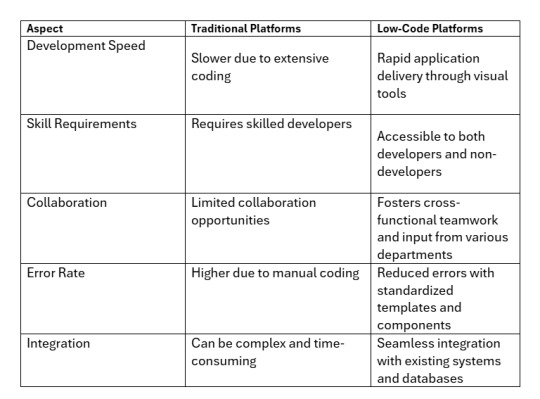
Hope you now ha’ve a clearer understanding of your next steps! Now, let’s explore the key stages of the low-code development journey.
Key Stages in the Low-Code Development Journey
Navigating the low-code development journey involves several essential stages to ensure successful application creation. Let’s break down these stages using the example of developing a mobile fitness application.
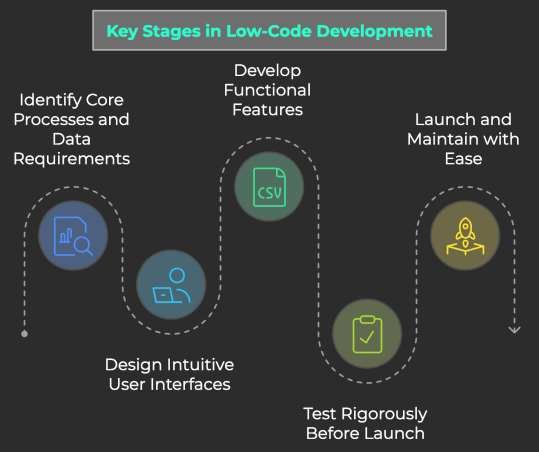
1. Identify Core Processes and Data Requirements: Before building your fitness app, it’s crucial to clarify the core processes that will drive user engagement. For instance, you might want to include features like workout tracking, diet logging, and user progress monitoring. Mapping out these processes helps you determine the data needed, such as user input, activity metrics, and nutritional information, in this case.
2. Design Intuitive User Interfaces: Next, think about how users will interact with your app. For a fitness application, you’ll need user-friendly interfaces for logging workouts or meals. Low-code/ no code platforms enable you to design these interfaces effortlessly using drag-and-drop functionality, allowing you to create customized fields that cater to user needs, such as exercise type, duration, and calorie intake.
3. Develop Functional Features: With your processes defined and interfaces in place, it’s time to construct the app. Low-code development empowers you to build robust features without extensive coding. For example, you can integrate a workout schedule that automatically adjusts based on user preferences, leveraging pre-built components to save time while enhancing functionality.
4. Test Rigorously Before Launch: Before launching your fitness app, thorough testing is crucial. Simulate user interactions to identify any technical issues or bugs. Low-code development platforms often provide testing environments where you can evaluate app performance under various scenarios.
5. Launch and Maintain with Ease: Once testing is complete, you’re ready to launch your fitness app. Low-code solutions simplify this process, allowing you to publish your application on various app stores with just a few clicks.
Additionally, these platforms facilitate ongoing updates and feature enhancements, enabling you to respond quickly to user feedback and keep your app relevant in a fast-paced market.
Onwards toward knowing about the hurdles and ways to dodge them!
Strategies for Overcoming Low-Code Development Challenges
Here are three common challenges along with their solutions to help you navigate the low-code journey effectively:
a. Limited Customization
Challenge: Low-code platforms may restrict customization, making it difficult to meet unique business needs.
Solution: Choose a flexible platform that allows for custom coding when necessary, enabling tailored solutions without compromising speed.
b. Integration Issues
Challenge: Integrating low-code applications with existing systems can be complicated, risking data flow and compatibility.
Solution: Select platforms with robust integration capabilities and APIs to facilitate seamless connections with other systems.
c. Governance and Security Concerns
Challenge: Increased access to development can lead to governance and security challenges.
Solution: Implement strict governance frameworks and security protocols to manage user access, data protection, and compliance effectively.
That’s all! By following these key stages and addressing the challenges in your low-code development journey, you can streamline your processes and create impactful applications that meet your user’s needs.
Learn more about cutting-edge tech developments with us at Nitor Infotech.
#application development#app softwares#mobile app development#mobile development company#low code#no code#software services#software development#blog#software engineering#Low-Code Development
0 notes
Text
The Future of FlutterFlow With Low-Code Development
Discover how FlutterFlow is shaping the future of app development, driving the $187B low-code revolution with faster, cost-effective solutions.
0 notes
Text
Top Reasons Why Businesses Need Low-Code Development In 2023
Know top benefits of low-code development, various low-code platforms, and applications that can be created with low-code platforms.
1 note
·
View note
Note
Why can't nii give Sakura interesting layers to his character outside " traumatized socially awkward teen" like any interesting new revelation about him? Give him close or special person " relative, friend" anything!
His distant and closed off personality is boring icl
From where? All the people who discriminate him?
If he had actually had people who had accepted him before, why would had him gone to try to gain a sense of self-worth by beating people up in the middle of who knows where?
Sakura's character goes taking shape as he gets to experience things beyond reject. Like how his favorite food is omurice, probably because it was (I suppose) the first meal someone has gave him because they wanted.
But if we're talking about something he is that can't be linked downright to his trauma and the shitty life he had, then that be his kindness. Bro doesn't have a single reason to be kind, he just is. Despite how people took that kindness coming from him.
There's also how bad at technology he is. You can't blame that on his lack of bonds. Suzuri has only just started playing games (finally) and he's already better at it than him. Meanwhile, Sakura has had his phone since before joining Furin and boy can't type a single message. Yeah, you could say he didn't have no one to text to, but has he never used internet? Google or whatever search engine Japanese people use?
To be honest, that only makes me wonder what did he do in his free time. I mean, teenagers without friends tend to spend their free time reading or online. Did he seriously just sleep? Did bro spent all day sleeping or fighting?
Bro, is this how you got so good at parkour? Did you go up in any given chance to avoid people to the point you can compete with cats?
This kinda just made his character funnier to me. Here there's a teenager with no friends nor social life, with an avaible phone, who never thought on using internet to waste time.
I got sidetracked. Anyways, yeah Sakura's trauma is a big part of his character. No, he probably doesn't have any positive bonds linking to anyone of his past. (If he had, then probably something bad would had happened for him to move away of them so...) Well, I don't think he has. And about the last part—
"Distant and closed off" is really just how he starts. He's defensive, yes. But he's terrible at keeping people away and literally can't reject their kindness. Just on the first chapters bro ended up carrying a mountain of food because he couldn't say no. He also finished it all.
There's also that funny scene when he carries granny Sato on his back all the way to Pothos— only for her to jump off his back and land in a superhero pose (we love granny Sato).
He also goes to Anzai's childhood friend (the girl one)— I don't remember if he went to know what was going on with Anzai or he asked because she was crying— and listened silently to her story. That's kinda why he followed Anzai and all that.
And then in the Noroshi arc, after getting his ass beat and finally winning Endo (in whatever sense you prefer), he still helped him to get to the roof to watch the Umemiya vs Chika (almost typed Chiaki— whoops, wrong fandom) fight.
He's not distant (despite his name), he's defensive (hence the tsundere behaviour), mostly when he's embarrased, and silent. He's also really naive ("Oh, you're foreigner?!" and literally every interaction with Suo, lol).
He also seems to be a fast learner when it comes to fighting (he literally uses Tsubaki's way of kicking after the gravel arc, has used one of Choji's move before, and then there's whatever he did in the bridge), seems to have strong morals, and he also hates hats and glasses. Though that last one is most likely related to his trauma (i think it was referenced before, but I could be wrong).
A pity you find him boring, I guess. You don't have to read it if you don't want. You can also read it because of someone else besides the main character.
#sadly for you people need social enrichment to help with their development#and is told and shown many times how lonely he was before#so the chances for him to have some worthy bond from his past are really low#sakura is more the kind of character to enjoy watching grow like you see a see become into a plant and then bloom#what you're waiting for positive familial revelations then#well look at Kiryu right now#we're literally entering in his family arc#i enfazise positive bc i wouldn't be surprised if we later learn Sakura's related to some dangerous people or smth#actually i hope it happens#is just a trope i like teheepero#i love sakura guys#he's so cat coded#and characters who are good despite having all the reasons to not be are a guilty liking of mine#but onky the ones that give me this specific feeling i can't explain in the tags#only* damn it#wind breaker#sakura haruka#asks
20 notes
·
View notes
Text
hello hi hello !
PLEASE READ THIS !!! i have an ask.
I've submitted a request to gamemaker, and I'd greatly appreciate anyone who can just quickly "upvote" my request to ibcrease the chances of it being cobsidered.
my request is one for better accessibility. game development shouldn't just be for sighted people, but with the way things are it's impossible as a visually impaired person to even begin.
it'd help out a lot if you could please help make it known these features are wanted and needed, and if you coukd reblog this post so it might get some reach.
#game development#game maker#disability#accessibility#blind#visually impaired#low vision#game dev#coding#Gamemaker studio#github
6 notes
·
View notes
Text
Had a moment of listening to music I liked back when I was a teenager (& still like) and having a whole. Realization . That I like myself as I am now sooooo much better than I like teenage me. And I started thinking about Why.
There's a lot to it I'm pretty sure, & most of it centers around the fact that I just... didn't really know who I was as a person. I didn't really have hobbies outside of what I did in school (aka orchestra) and like. Video games + anime. I did creative writing in middle school, but dropped off in high school for... some reason? I still made original characters and played around with them a lot, but it was mostly just in drawing and thinking about them. I never actually *wrote*, and I in fact didn't get back into creative writing at all until I was 23 years old. I was someone who had spent so long hiding behind others and just doing what I was told that I just... didn't have any real direction. I didn't know what I even *wanted*. I thought I knew, but in hindsight, I can confidently say that I didn't. I was just an insecure teen drifting through life and not thinking about things beyond what was immediately in front of me. Which is pretty standard for teenagers I guess, but not all of them. Not at all.
Compared to now, where I have Many hobbies, most notably being writing. As I am now, I am just Intrinsically a writer. And it's weird to remember that I wasn't even really *writing* before 5 years ago (besides text rps, which did a lot for developing my writing skill! But still aren't a replacement for writing individually). As a teen, I wasnt into dnd, I was incredibly out of shape, & I was a lot less aggressive and focused. I was the type to avoid sports!!! I hated them!!!! But as I am now, I Love biking and can easily bike for an hour+ no problem (I remember being a teen and trying to go on just 10 minute bike rides in the summer and just *dying* from it), & I love working out. I wanna be strong!!! I LOVE being strong!!! And I was an absolute mess with things like public speaking & working in groups, vs now where I can do an impromptu presentation no problem & I'm often the unofficial leader in group projects bc im typically the one who does the organizing and allotments of work. A side effect of working as a supervisor and then assistant manager for so long. I have a lot more confidence in my perceptions and judgements, & I have the self-assurance to assert these things. And this is only really the tip of the iceberg with all the differences.
I just feel like an entirely different person, almost. The cores are the same, or at least damn near similar, with the things I want out of life & the sorts of things I enjoy, but it's like. The difference between finding a random rock off the side of the road & then that rock when it's been sanded and carved and decorated to be something individual and unique. You look at them side by side and it's something dull vs something shiny and intricate. The origins can't be ignored and dismissed, & I certainly would never resent younger me for just doing the best with what I knew at the time. But it's just astounding how much difference time and experience will have for growing and developing as a person. Things I consider integral to my personhood weren't even thoughts in my mind back then. We are almost entirely different people.
#speculation nation#under readmore bc I just got contemplative. not negative really either.#ultimately it's that kind of thing of like. college & all my experiences within it have done a LOT for developing who i am as a person.#i wouldnt be nearly so comfortable with public speaking if it werent for how many speech classes ive taken over the years.#but it's also the fact that i was working to figure out who i was during college that made me fumble it so hard.#i wanted to be an engineer. can you believe it? i was so CERTAIN of it as a teenager. but it was only really bc of the family i have/had#that are/were engineers. i didnt have personal interest in it. it was just the Thing To Do.#so i got to college and i *hated* it and i had to take several years to figure out what i actually Wanted.#i realized pretty quickly that i wanted to focus on computers after my first coding class. but thats so BROAD#and computer science wasnt for me either. i fucking hated computer science. but computer information & technology??#this is my shit. and honestly it's so weird to remember that just 10 years i knew very little about computers#and now ill be sitting in my web programming class & theyre talking about javascript and loops and such within it#and im just zoning tf out bc Yeah Yeah do while loops ive heard it a million times before. arrays?? yeah whatever i got it#but back in 2016 i had to learn these things for the first time!!! it was entirely new to me!!! teenage me didnt KNOW#so me being a computer person with a specialization in business and hobbies of writing and biking and dnd. i had NONE of those things!!!#i didnt even collect knives!!!!! granted thats mostly bc i Couldnt buy many of them yet + i also didnt have much money lol#bc i never even worked a job until i got to college. that's also unimaginable to me. imagine not knowing what it's like to Work...#i remember getting $500 or so in graduation gifts after graduating high school & my mind was just Blown#had never had that much money before. it was crazy to me. meanwhile with a job paying every other week $500 was a *low* paycheck.#but i also have to pay bills and rent and buy food and all this stuff. also things i didnt have to worry about back then. ALSO weird.#idk theres a lotta bullshit i gotta deal with as an adult but i like who i am now so much better. feel so much more *myself*#than just a directionless teenager waiting for someone to tell them what to do.#it's amazing what 10 years will do for your development as a person. absolutely wild.
2 notes
·
View notes
Text
We are a top IT consultancy company and no code and low code development service providers. By designing, building and automating, our aim is to turn your ideas into reality. No-code and low-code development creates no-code SaaS solutions, automate workflows, streamline app development and empower businesses to build apps without extensive and manual coding. Businesses can automate workflows and rapidly develop apps by leveraging no-code and low-code development platforms. Without traditional programming, digital strategies are transformed, processes are streamlined and no-code SaaS development is driven.
#low code development#no code development#web developing company#software#information technology#web development
4 notes
·
View notes
Text
How Low-Code Platforms Are Transforming Healthcare and Elevating Patient Experience

The healthcare sector is a highly evolving landscape. The current race for digitization has made it crucial for service providers to stay updated with the latest technology and regulations. Patient satisfaction is of the highest requirement, but inefficient processes, paperwork, and security concerns often hinder positive outcomes. To enhance speed, transparency, and efficiency, many providers are turning to low-code platforms, driving digital transformation.
Why Low-Code is a Perfect Fit for Healthcare
Low-code platforms enable both technical and non-technical users to build digital healthcare solutions. It simplifies healthcare operations, speeds-up processes and makes healthcare more accessible for patients.
Most healthcare professionals lack IT training, limiting their ability to use digital tools. Low-code bridges this gap by providing an intuitive interface for rapid, cost-effective app development. With scalable architectures and seamless third-party integration, these platforms improve workflows, patient care, and operational efficiency.
Key Benefits of Low-Code in Healthcare
Workflow Optimization and Automation:
Low-code platforms like iLeap streamline administrative and clinical processes. Automating billing, budgeting, and resource management reduces manual effort and errors. Tasks like appointment scheduling and reminders can also be automated, freeing up time for patient care.
Seamless Integration:
A majority of legacy healthcare enterprises rely on legacy systems which is often a major reason for downtimes and slow processes. A robust low-code platform integrates easily with existing software and third-party applications, ensuring unified workflows without IT disruptions.
Customizable Features:
Low-code solutions automate emails, manage patient records, and schedule appointments efficiently. Platforms like iLeap also support threshold management and escalation for timely responses to critical situations.
Enhancing Patient Care with Low-Code
Patient Registration and Records :
Custom applications streamline patient intake, scheduling, second opinions, and billing, reducing wait times and improving experiences.
Automated Appointment Reminders and Feedback:
By automating reminders and surveys, healthcare staff can focus on critical tasks, reducing no-shows and improving service quality.
Telehealth and Centralized Communication:
Legacy systems cause fragmented communication and delays. Low-code platforms facilitate telehealth solutions, including video consultations, secure messaging, and EHR integration, ensuring timely care.
Compliance and Accountability:
Regulatory compliance is crucial. Low-code solutions streamline reporting and documentation, ensuring transparency and adherence to guidelines. By 2030, on-demand compliance reports will be necessary, making digital transformation essential.
iLeap: Driving Digital Healthcare Transformation
iLeap enables healthcare providers to build secure, scalable applications tailored to their needs. By optimizing workflows, financial management, and patient experiences, iLeap helps organizations stay ahead in digital transformation.
Learn more about iLeap’s low-code application development platform. Schedule a call with us
2 notes
·
View notes
Text
Maximizing Efficiency: What Ops Leaders Should Look for in a Sales CRM
For sales operations leaders, choosing the right Customer Relationship Management (CRM) system is essential for driving productivity, enhancing customer relationships, and ensuring smooth sales processes. A CRM serves as the central hub for managing customer interactions, tracking leads, and streamlining workflows. However, with numerous CRM options available, ops leaders must focus on specific features to maximize efficiency.
Here are the key aspects ops leaders should prioritize when selecting a sales CRM.
1. Automation Capabilities
A primary factor in boosting sales efficiency is automation. Repetitive tasks such as lead assignments, follow-up emails, and data entry can be time-consuming for sales teams. A CRM with automation features can reduce these burdens and free up sales reps to focus on more strategic activities.
For example, workflow automation allows actions like assigning leads to specific team members or triggering email follow-ups based on predefined conditions. By automating such tasks, the CRM ensures consistency, reduces manual errors, and accelerates the sales cycle.
2. Integration with Other Tools
In today’s sales environment, teams use a variety of tools for marketing, customer support, and analytics. A CRM that integrates seamlessly with these systems enhances operational efficiency by centralizing data. A strong integration ecosystem allows for smooth data flow between different platforms, eliminating the need for manual data entry.
Ops leaders should look for CRMs that integrate with tools like email marketing platforms, customer support software, and analytics dashboards. This will ensure that sales teams have access to comprehensive customer data, helping them make informed decisions and personalize their approach.
3. Data Analytics and Reporting
A CRM is only as effective as the insights it can generate. Ops leaders need robust data analytics and reporting features to monitor sales performance, track KPIs, and identify areas for improvement. A CRM should offer customizable dashboards and real-time reporting tools that allow sales teams to track metrics like conversion rates, win rates, and sales cycle length.
Advanced analytics features such as predictive forecasting and trend analysis can also help ops leaders make data-driven decisions, allocate resources more efficiently, and refine sales strategies.
4. User Experience and Adoption
For a CRM to be effective, it must be easy to use and adopted across the sales team. A user-friendly interface with intuitive navigation reduces the learning curve and encourages widespread adoption. Sales reps should be able to access customer data quickly, update records easily, and perform tasks with minimal friction.
A mobile-friendly CRM is also important, as it enables sales reps to access critical information while on the go. Additionally, the ability to customize the system to match team workflows ensures that the CRM aligns with the unique needs of the business.
5. Scalability and Customization
As your business grows, so do the complexities of sales operations. A CRM that can scale with your organization is essential for long-term success. Look for a CRM that offers flexible pricing, the ability to add more users, and features that grow with your team’s needs.
Customization is another important aspect. The CRM should allow you to tailor fields, reports, and workflows to meet the unique requirements of your business, ensuring that it remains a valuable tool as your sales processes evolve.One key trend in the CRM space is the rise of low-code CRMs, which offer a balance between customization and ease of use.
Conclusion
Selecting the right CRM is crucial for ops leaders who aim to maximize sales efficiency. By prioritizing automation, integrations, data analytics, user experience, and scalability, ops leaders can ensure that their sales teams have the tools they need to succeed. A well-chosen CRM will streamline operations, improve decision-making, and ultimately drive revenue growth.
#Low-Code Platform#low code platform development#no code low code platform#low code app development platform#low code app development#best low code platform#benefits of low code no code platforms#low code no code platforms for mobile app development#low-code development#low code application developmet#low-code software
1 note
·
View note
Text
Future-Proofing Your Business with the Right Low-Code Platform
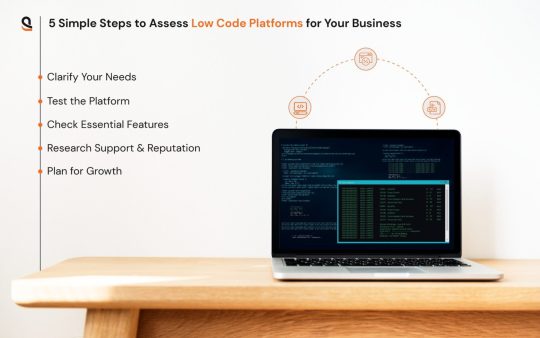
Businesses today need to move fast to stay competitive. Traditional software development takes time, money, and skilled developers—resources that many companies can’t afford to waste. That’s where low-code platforms come in. They make it easier to build apps, automate processes, and innovate without the need for complex coding.
What is a Low-Code Platform?
A low-code platform is a development tool that allows users to create applications using a simple drag-and-drop interface instead of writing thousands of lines of code. It empowers businesses to build apps quickly, integrate with existing systems, and improve efficiency with minimal technical expertise. This means faster innovation, lower costs, and better collaboration between teams.
Why Low-Code is a Game-Changer for Businesses
Businesses across industries are turning to low-code platforms to streamline operations and improve productivity. Here’s why:
Faster Development: Build applications in days or weeks instead of months.
Cost Savings: Reduce dependency on expensive development teams.
User-Friendly: Even non-developers can contribute to building and automating workflows.
Easy Integrations: Seamlessly connect with databases, APIs, and business tools.
Scalable Solutions: Whether you’re a startup or enterprise, low-code platforms grow with your needs.
Boosts Innovation: Enables rapid prototyping and real-time modifications.
Mobile-Optimized: Many platforms come with built-in mobile support for better accessibility.
What to Look for in a Low-Code Platform
With so many options available, how do you choose the best low-code platform? Consider these factors:
Ease of Use: Look for a simple, intuitive interface.
Customization: Ensure the platform can be tailored to your unique needs.
Security: Strong data protection and compliance with industry standards.
Automation Capabilities: Reduce manual tasks and improve efficiency.
Collaboration Tools: Multiple team members should be able to work together effortlessly.
AI & Machine Learning Features: Some platforms come with AI-powered analytics and automation.
Pre-Built Templates: Accelerate development with ready-made components.
How Different Industries Are Using Low-Code
From healthcare to finance, low-code platforms are making a big impact. Here are some real-world applications:
Healthcare: Automating patient record management and appointment scheduling.
Finance: Developing AI-driven chatbots and fraud detection systems.
E-commerce: Personalizing shopping experiences and streamlining inventory management.
Manufacturing: Optimizing supply chain tracking and predictive maintenance.
Education: Creating e-learning portals and online student management systems.
Real Estate: Simplifying lease tracking, tenant communication, and digital contracts.
The Future is Low-Code
The demand for low-code platforms is growing rapidly as businesses realize the power of faster, smarter, and more affordable software development. Whether you’re a small business looking to optimize operations or a large company aiming for digital transformation, low-code can give you the competitive edge you need.
Take the Next Step
Curious to see how low-code can revolutionize your business?
👉 Read the Full Blog Now to explore the best low-code platforms and find the right one for you.
The future is low-code—don’t wait to embrace it!
1 note
·
View note
Text
haha it's so awesome that Qi Xiaotian is like. canonically romance averse and implied to be nonpartnering. and everyone respects that. it's so awesome that nobody ignores that part of his character for a ship that kinda sucks. right.
#im not tagging this as anything fandom the last time i posted about xiaotian being aro coded i got a ship discourse blogger in my notes#and they were misinterpreting my post because DUH. thats what discourse bloggers do. they love being bad at reading.#'huhuhu romance being used in place of character development is ok when the characters influence each others development' i mean yeah.#thats not what i was saying. can you take this 3rd grade reading comprehension test rq for me please.#anyways if that blogger sees this#know that i based a shithead traumatized loser spidersona off of that interaction#they delete their discourse blog and it shows that theyve matured as a character#and they now have better priorities and theyre on the way to recovering from trauma#so. i hope that was blatant enough for you?#idk i can never tell whats too vague for discourse bloggers. you can never know how#uhm#theres no nice way to say this. you can never know how stupid a discourse blogger can be#there is always a new low! keep digging! (please dont. delete that damn blog and put that time and energy into like.#idk#fixing the roads in your city or something#or whatever problems are most prevalent in your area#anyways that individual was so fascinating. bro i am complaining about amatonormativity how do you not see that. ur apparently aroallo!
4 notes
·
View notes